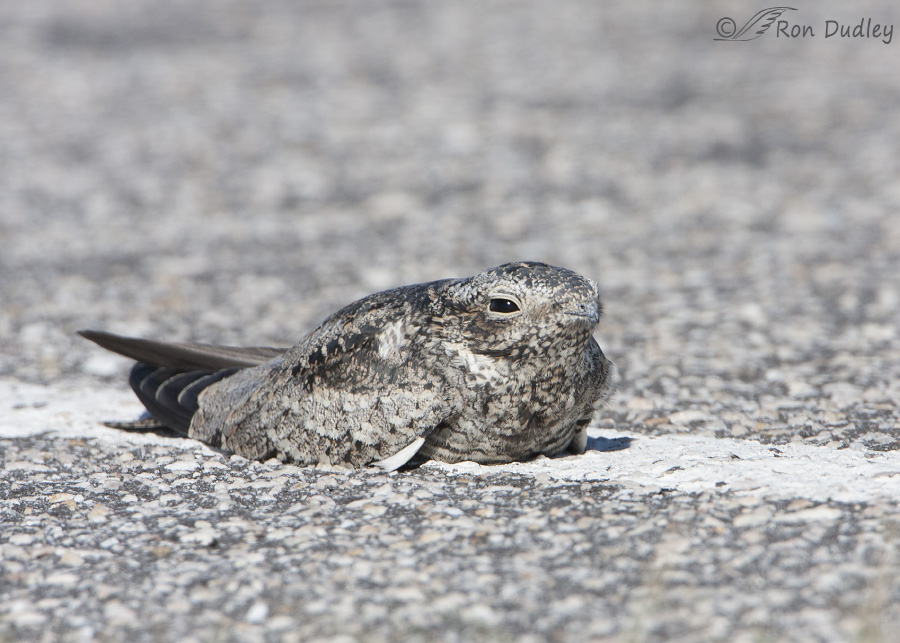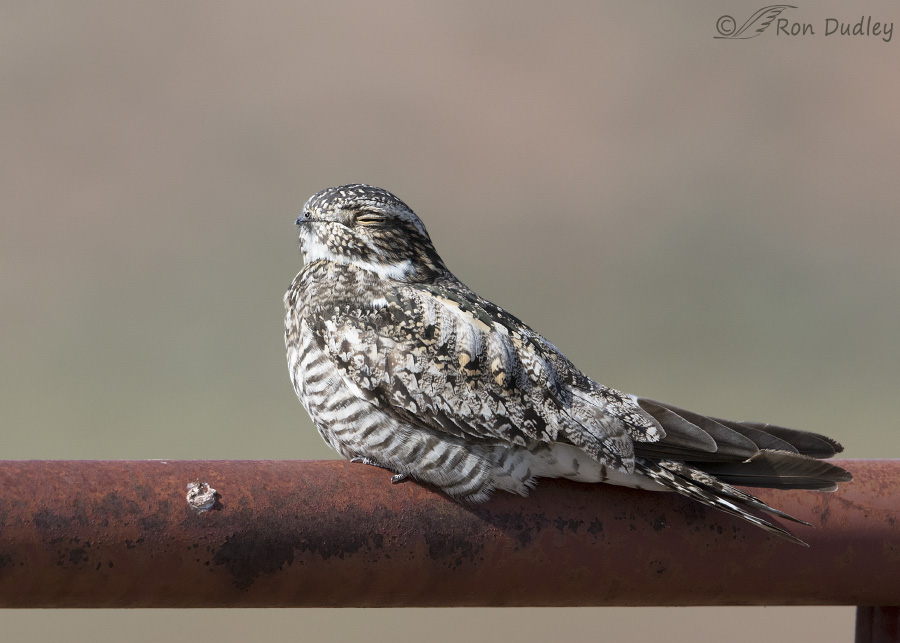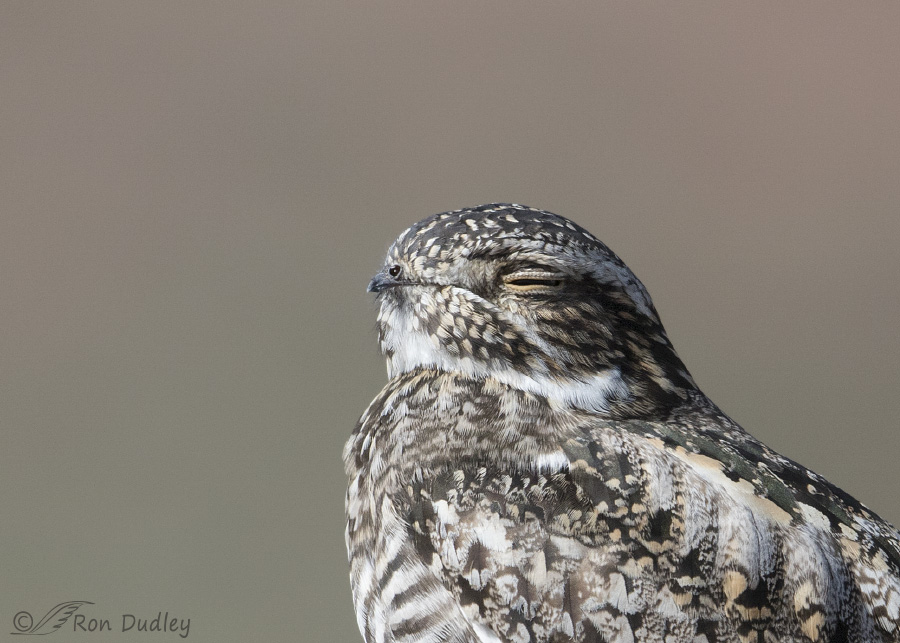Nighthawks are mysterious and unusual birds in more ways than one.
They’re seldom seen except in flight in twilight, they perform spectacular booming courtship dives that often mystify and enchant the observer (and listener), they typically perch lengthwise on horizontal objects and their flight patterns resemble those of bats (hence the colloquial name “Bullbat”). And their name is doubly misleading – they’re not particularly active at night (preferring twilight instead) and they’re not a hawk.
In addition they exhibit another unusual behavior that I’ve long been curious about.
1/1000, f/9, ISO 400, Canon 40D, Canon EF 500mm f/4L IS USM + EF 1.4 Extender, not baited, set up or called in
I’ve photographed perched Common Nighthawks 4-5 times over the years and each time the bird kept its eyes closed almost the entire time I was with it. This nighthawk, photographed several years ago, was resting lengthwise on a painted white strip on a road on Antelope Island (I’ve posted this image previously). I spent about 20 minutes very close to this bird (on foot rather than in my pickup) and its eyes were closed almost for the duration. I took several hundred shots and only got a handful where its eyes were open like this.
1/2000,f/7.1, ISO 400, Canon 7D Mark II, Canon EF 500mm f/4L IS II USM + EF, not baited, set up or called in
Six days ago I photographed this Common Nighthawk on a metal gate in northern Utah and this one never did open its eyes. I’m unaware of any birds other than nighthawks and related nightjars that do this so my curiosity prompted me to research the behavior but I found nothing on it.
I have my own working theory. Both nighthawk behaviors and their plumages are incredibly cryptic (serving to camouflage an animal in its natural environment) and I can’t help but wonder if it’s a camo strategy. Many animals including some butterflies, reptiles, cats, birds and fish have eyespots on their bodies (patterns and structures that resemble eyes in places where eyes wouldn’t be) meant to fool potential predators by disguising the actual location of their eyes and head (though eyespots also serve other functions). Pygmy Owls and American Kestrels are well known for having eyespots on the back of their heads.
So, wouldn’t another effective strategy for nighthawks be to keep their eyes closed in daylight while they’re on an exposed perch? The presence of obvious eyes helps predators (and even bird photographers) spot cryptic prey. As you can see in the first photo above nighthawk eyes are dark and they really stand out against a lighter colored eye ring and face.
But are their eyes really closed?
Nope, they often aren’t – at least not all the way.
A tight crop of the previous image makes it more clear that the nighthawk was really “squinting”. I was very close to the bird and there’s no way it wouldn’t keep a close eye on me at that distance. We all know from squinting ourselves that our eyes have to be open very little for us to see out of them.
It’s only a working theory but it’ll be mine until I see contrary evidence. If any of my readers know differently I’d love to hear about it.
Ron
PS – If you’re curious about the “booming” courtship display of the Common Nighthawk the Cornell Lab of Ornithology has this video clip explaining what it’s like to experience it.
And here’s another clip some might enjoy seeing – it’s particularly interesting at about 17 sec in the timeline for the booming sound their feathers make in a dive.
Late Addendum: Here’s a link to a video clip (sent to me by April Olson) showing a physical exam of a Common Nighthawk by either a vet or a rehabber. It’s an extremely interesting clip that among other things explains that nighthawks have voluntary control over pupil size. That suggests to me that they wouldn’t use squinting to regulate the amount of light coming into their eyes.





Ron, I’m going to cast a belated “vote” for the idea that Nighthawks keep their eyes closed during the day because of sensitivity to light. Even if they can effectively control their pupil size, it may be easier and more comfortable for them to just keep their eyes closed. My only real experience with Common Nighthawks was on a trail in the hills above southern California. For a few weeks I’d hike a trail starting about three a.m., wearing a small halogen headlamp. Nighthawks would sit on the trail, and when I’d first approach them the light from the headlamp would be reflected back as a dull, whitish light. Turns out it was because the bird’s nictitating membrane was closed while the eyelid was open. When I got close enough to the bird that it was startled (unavoidable as it was a narrow trail), it would open the membrane and then the eye would reflect back a bright yellow color (from the iris). Just a guess, but I’m thinking that maybe Nighthawks prefer to have the pupils constricted except when they need full vision in the dark or near-dark (e.g. when they’re hunting).
Ron,
David Attenborough, in The Life of Birds, has a segment with a Potoo and shows several ways this bird manipulates its eyelid to camouflage its eyes and still see.
I think the open eye in your top photo calls attention to itself, while with its eyes closed, the bird has a better chance of blending in with its surroundings.
Love these photos and the videos.
Thanks!
Sue
One of my Persian Cats has what looks like eyespots on the back of her neck but I don’t think she has anyone fooled(lol). Would love to see a Nighthawk in real life especially after this article, Ron. Thank you!
Fascinating. I immediately thought of our tawny frogmouths (often mistaken for owls) ( links to explore here.and the camoflague issue was immediately evident. I worry about the roosting on the road issue though.
Thanks for that link, EC. I’d heard the name of the bird before but if I ever knew what it looks like I’d forgotten. What an unusual bird! “False owl” indeed.
Here’s a link to an excellent video clip about a physical exam of an injured nighthawk that I think many of my readers would be interested in seeing. Note what she says about control of pupil size and how that might relate to the reason for squinting. https://www.youtube.com/watch?v=qpBWTZmkoSQ
Very interesting as always. And beautiful photos! I have never seen a knight hawk but I have run into a few eastern whippoorwills – lovely mysterious birds.
Thank you, Joanne.
I first ran into Nighthawks and Poor wills in the rehab. They are amazing birds in many ways. They are ground nesters and often roost on the ground. Their main defense is camouflage. They freeze and try to look like a snag or old dead limb they align on dead branches or blend in on a pebbly ground. They spend the daytime sleeping with just a tiny slit of one eye open. In the rehab when we pick them up they play dead and will not move, eyes still closed.During the day they are motionless at the rehab but at night when it is quiet they will move round a lot. They have owl like soft feathers and a quiet flight.
Thanks for providing that very interesting natural history, April!
I’ve wondered if their perching along the horizontal is due to an instinct to better blend in with a branch, but then wondered why I saw them on the ground…the ones I saw on the ground didn’t suddenly fly up in my face when I almost stepped on them (like the heart-stopping explosion of a pheasant or a partridge), but remained in place, unmoving…I thought they were dead, but Ben assured me they weren’t…
Patty, they do both – roost on the ground and on branches or other horizontal objects.
I find Nighthwks mysterious…the ones I saw when Summer camping with Lakota friends in Colorado were either hunkered down, unmoving, on pebbley ground–so well blended in with small stones that I almost stepped on them or swooping around like mini-jets–in their feeding flights at twilight and dusk. My friend, Ben George Littlemoon, described one of the sounds they made as a “fart”…the other as “peet”…at first, I thought they were bats….
Patty, I put my hand within just a few inches of that bird to try to get it off the road and it didn’t budge. I can see how you could almost step on one.
I wonder if their eyes could be fixed-dilated since they fly at night (and dusk and dawn. They are so black I wonder if this could be part of the reason. If so, opening their eyes in bright sunlight would be very painful. Squinting would help. Just a thought… Great photos! As always, I look forward to your photos each day you post them – thanks so much for being so generous!
I had someone else suggest your theory on Facebook, Jan. I just don’t know…
I could ask someone to check too see if there eye dilates with a light next time there is one at the rehab.
Their eye, sorry I can’t type and talk at the same time anymore.
Excellent post! Such interesting-looking birds and very cool wing sounds. Reminds me of the Allen’s hummers doing their aerial display, though their wings at speed sound more like a (tiny) screaming jet than the nighthawks’ “boom.” Thanks for providing the video links. But I’m curious — finding that bird on the pavement like that, is that a common occurrence? Are they quick to react to oncoming traffic or do they not realize they’re in imminent danger?
I’ve never before seen one on a pavement stripe, Chris, so I don’t know how common it is. But they often instinctively roost on horizontal objects and I’m sure that’s why it chose the stripe.
Beautiful shots Ron and thanks for the post!
Thank you, Dick.
I’ve seen Nighthawks once, flying at dusk, on an evening when we were helping out with astronomy night at Hueco Tanks. Very interesting birds. I like your theory that they are squinting rather than just keeping their eyes closed. It makes way more sense that they would remain alert to their surroundings, rather than just pretending they are invisible. Unfortunately I couldn’t get the Cornell video to work on my computer.
Sorry the video wouldn’t work for you, Susan. I thought it was interesting.
We have Common Nighthawks in my neighborhood, and I once found a dead one. Curiously it has a tube nose – the nares covered by a ridge of hard material much like albatrosses and shearwaters. I wrote to Cornell inquiring about this and they acknowledged that yes, that was in fact how their noses were constructed, but they did not know why. That was some years ago. Any one else read anything about that?
Sallie, I can’t help but wonder if their unusual nose construction is a baffle of sorts (similar to what falcons have) to disrupt the flow of air into their lungs at very fast speeds. If you look at the last shot it looks like a falcon nose cone in the nostril. Just a guess…
Your hypothesis sounds totally reasonable, especially considering the “I’m still watching you” squint. They have such beautiful markings too. Thank you for the video links (cool rainbow!). Now I’m curious as to the purpose of the underwing blazes.
I can’t help wanting to chase that first guy off the road — lest he become a recipient of a Darwin Award — every time I see him. 😉
Marty, That was my concern with the first bird too – which is the main reason I spent so much time with it. Thankfully there was absolutely no traffic on the road before the bird flew off. If I’d seen a car coming I’d have forced the issue with the bird.
LOVE Nighthawks! 🙂 Sounds like a good theory to me. We have a few in summer and they work over the creek in the evenings.
Judy, the first time I ever noticed nighthawks was while I was camping in a Montana canyon many years ago and there were a bunch of them doing their booming courtship display. So I always associate nighthawks with your neck of the woods.